HP Z27q Monitor Review: Aiming For More Pixels
by Brett Howse on December 22, 2015 8:00 AM ESTAdobeRGB Calibration
AdobeRGB tests are done with the same workflow as sRGB, but with the target gamut set to AdobeRGB. As with the sRGB, precalibration results are done for 200 nits, and then calibrated results are done for 200 and 80 nits.
Grayscale
Set to AdobeRGB, the pre-calibration results are quite a bit improved over the sRGB values. They are so good that there is actually little reason to calibrate this display if you are using it for AdobeRGB. The average error rate on grayscale is only 1.08, and the gamma curve is almost perfect. The white point is very close to correct as well.
Saturation
Saturations are very good again, with an average error of just 0.5. This is a great result for an uncalibrated display, and you can see that it easily covers the much wider gamut of AdobeRGB here.
GMB
I feel like a broken record a bit, but the pre-calibration results for GMB are fantastic, with an average error of just 0.462. HP has done a fantastic job on the AdobeRGB LUT for this display.
200 cd/m2 Calibrated
Since the pre-calibration measurements were so good, there would be very little if any need to calibrate this display, but for completeness that has been done.
Grayscale
Although the couple of spikes for grayscale have been corrected, the overall result is actually slightly worse than out of the box. The gamma jumps up, and the white point is off. The results were better before, so if I was using this I would throw this out and leave it at stock.
Saturation
With the white point slightly moved, the overall error rate has actually gone up. It’s still excellent, but not as excellent as before.
GMB
The final test also has a higher score, which at 0.67 is still excellent, but the calibration did nothing to help this display on AdobeRGB gamut. Let’s see how it does at 80 nits.
80 cd/m2 Calibrated
Setting the display to 80 nits, it was then calibrated again.
Grayscale
Overall the result is very good again, although the gamma is not as flat as it was before calibration. The white point and average error rate are both very good though.
Saturation
Much like at 200 nits, the pre-calibration measurements are actually better again, but the end result even with the slightly worse scores is still a very accurate representation of the AdobeRGB color space.
GMB
A result of 0.96 is very good, and the Z27q pretty much had no issues with any of the colors in our Gretag Macbeth test.
Relative Color Comparator - Displayed color on bottom, correct color on top
The results from AdobeRGB are even more impressive than the sRGB space. The Z27q can easily hit pretty much 100% of this target gamut, and the built in LUT is incredibly accurate when targeting AdobeRGB. This is one of the rare times were calibration pretty much did nothing.


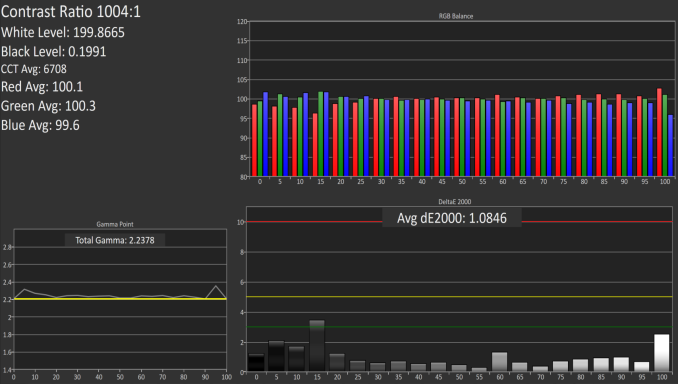
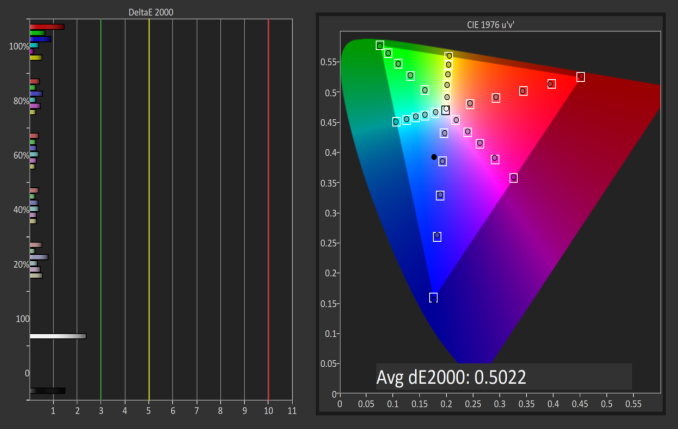
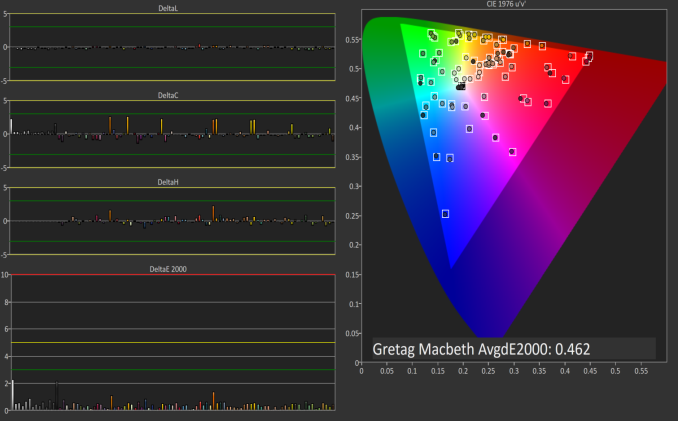
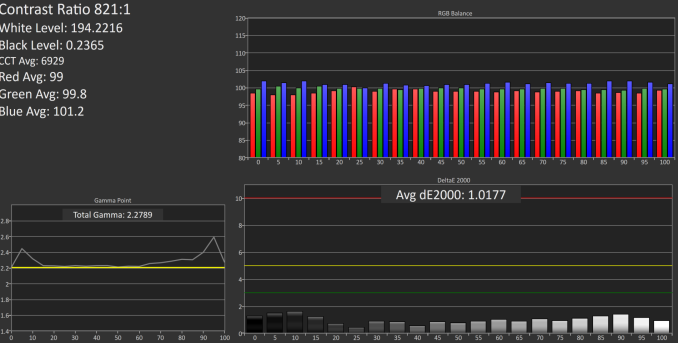
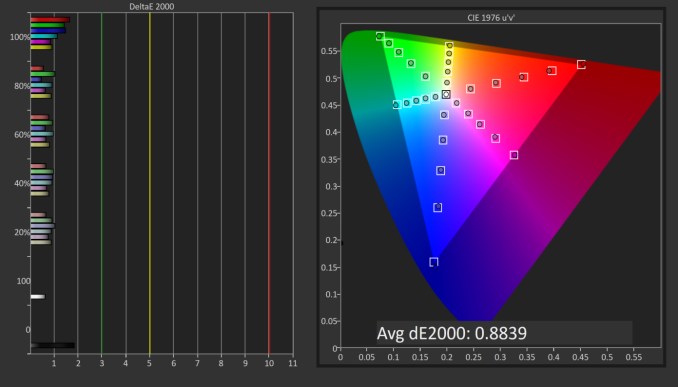

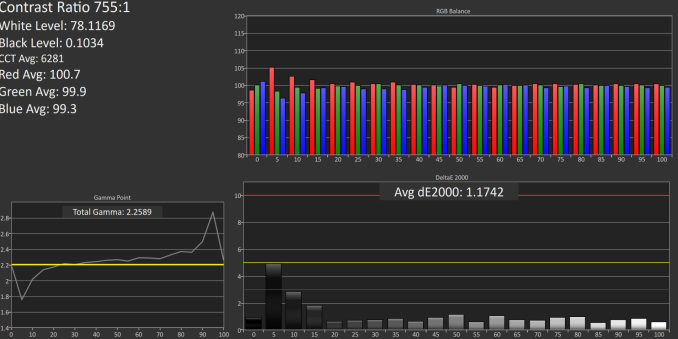











92 Comments
View All Comments
SanX - Monday, December 28, 2015 - link
I am surprized that you have started arguing having no slightestclue in the main basic thing of monitors. It is not the screen 103PPI what
matters but perceived PPI based on resolved angular dimensions of the pixels.
This and other factors also define optimal viewing distance.
The optimal distances are set by the TXH and SMPTE standards
and not the length of your legs. For 4K monitors perceived PPI are
almost whopping 600 and head turning 717 respectively. This makes 43"
TV too small for normal PC use and you have to put it closer to your
nose to utilize this excessive PPI. That in turn what causes discomfort,
and that is why you need larger size TV. Where Anandtech finds such
technodumbos like you? If you will start scaling PPI to be able see
the small fonts clearly that means trashing all 100% of spent money
on your "arguably better quality IPS panel" because those small scaled
fonts look uglier then on even 1080 one.
And yea, go and tell your mom that that you feel +5ms when there always
exists the intrinsic 100ms lag in human reaction. It's not the difference
between 21ms and 26ms which is 20-25% but the difference between
100+26ms vs 100+21ms or less then 4%, you genius. ROTFLMAO.
Tell also mommy that 44 ms is unacceptable for the static content
of the screens like text editing and browsing.
AnnonymousCoward - Tuesday, December 29, 2015 - link
> This makes 43" TV too small for normal PC useHilarious. Who could possibly take you seriously?
> this excessive [103] PPI
Again, huh?
> the intrinsic 100ms lag in human reaction
You're confusing reaction time with feedback lag. I score 240ms in online reaction tests but can sense 30ms of feedback lag. Reaction time includes the time to process stimulus and physically move something. Feedback is a different thing, since you're measuring the lag from what you already moved.
There are many thousands of others on the web who agree with what I'm saying. Take a look at the highly respected TFT Central: http://tinyurl.com/ngweqd9 They classify more than 32ms as "some noticeable lag in daily usage"! Whaduya know! 44ms is even off their chart.
Convinced yet? There's nothing wrong with being mistaken and learning, but staying in stubborn ignorance is foolish.
SanX - Tuesday, December 29, 2015 - link
Comprehension problems? Funny, no single my point was gotten. How i know that? I intentionally made a mistake in my numbers and you did not catch that ROTFL. What i said about DPI and lags, can repeat with your own words?This is 4th repeat that 44ms is for static contents use in PC mode. You will not notice the lag there, lag is noticeable if you move mouse fast. For fast games the Game mode exists with 20ms display lag in JU7500 and 26ms in JU7100, see Rtings "PC Monitor" and DisplayLag 2015 database which rate these monitors as excellent or very good. BTW, LG has even larger lag 55ms and i know people who still use it even in games. This is due to another point you did not get while - this is truly hilarious - trying to teach me what is what: in games the human reaction lag is more important than display lag and is always present. Think again about this if you actually can
AnnonymousCoward - Tuesday, December 29, 2015 - link
I destroyed pretty much all your claims, and yet you stay in ignorance and say things like "go tell mommy".SanX - Wednesday, December 30, 2015 - link
ROTFL. You can not even repeat in your own words what I said, "destroyer". And yea i'd suggest your mommy to take your Gameboy off.Guspaz - Monday, December 28, 2015 - link
You guys should take a look at the Asus PG279Q. 27", 1440p, IPS panel, 165Hz, G-Sync. I don't think I've seen any detailed reviews of it (the kind that actually benchmark it), although LinusTechTips did measure input lag at 12.5ms, which isn't bad.SanX - Tuesday, December 29, 2015 - link
Minor typos:THX 492
SMPTE 597
sharath.naik - Wednesday, December 30, 2015 - link
To have a usable 5k monitor. Below is the spec that would have the same PPI as a 4k 27 inch monitor.Display size: 36 inch
Screen curved.
Given this is still the minimum size for 5k you will still be sitting very close to the monitor, a flat panel will make it very hard to view the edges. So a curved screen is a must. This is for any manufacturers if they are reading this.
If not the above may be 2 27inch 4k monitors make more sense and is going to be cheaper too, and more convenient in terms of connectivity.
AnnonymousCoward - Wednesday, December 30, 2015 - link
Sorry to say, but your "spec" of 5K 36" curved won't be of any use to any manufacturer. They don't choose resolution and size based on what 1 random dude on the internet posted.